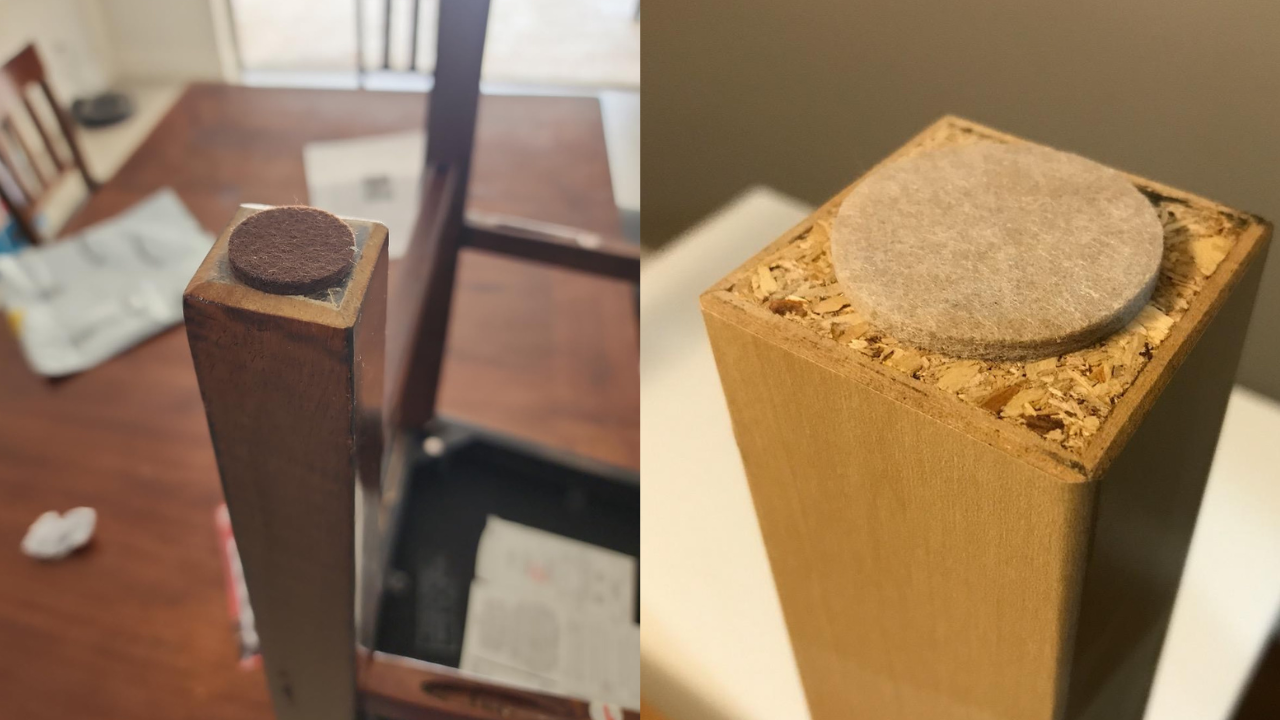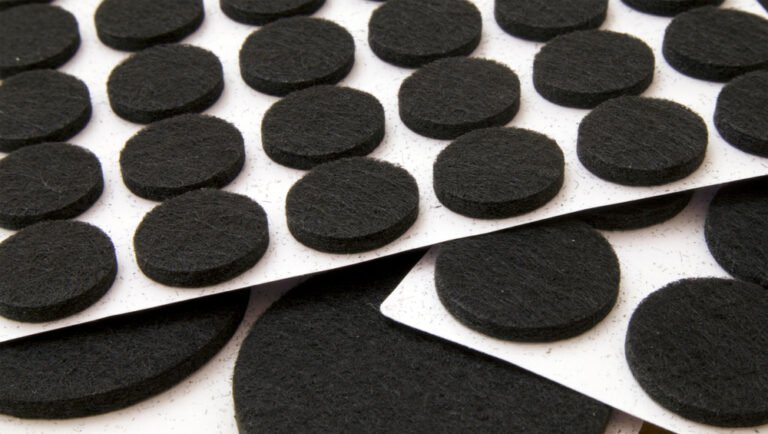Exploring how felt pads can help dampen sound and reduce noise from moving furniture.
Hardwood floors are a beautiful and timeless choice for any home, admired for their elegance and durability. However, one common issue homeowners face is noise. The impact of footsteps, furniture movement, and other daily activities can create an unwanted sound that echoes throughout the space. Thankfully, noise-reduction felt pads offer a simple yet effective solution. By absorbing shock and dampening sound waves, these pads can significantly reduce noise on hardwood floors, creating a more serene living environment. This article will explore how noise-reduction felt pads work, their numerous benefits, and tips for choosing and maintaining them.

Table of Contents
Understanding Noise on Hardwood Floors
Before diving into how felt pads work, it’s essential to understand why noise occurs on hardwood floors. Hardwood floors are known for their firmness and durability, but these characteristics can also contribute to sound amplification. When someone walks on hardwood flooring, the impact of each footstep creates vibrations that resonate through the floor. Similarly, dragging furniture across the floor can create scratching noises that may be disruptive.
The Physics of Sound on Hard Surfaces
To understand how felt pads can help, it’s crucial to recognize the physics behind sound on hard surfaces. Sound travels in waves, and when it encounters a hard surface, like hardwood, it reflects rather than absorbs. This reflection can amplify noise, increasing volume levels in adjacent rooms or even floors below.
Moreover, hard surfaces lack the damping properties of soft materials, which typically absorb sound energy. As a result, sounds generated on hardwood floors can be deafening and disruptive. This is where felt pads come into play.
What Are Noise Reduction Felt Pads?
Felt pads are small, soft discs made from densely packed fibers. They are designed to be placed under furniture legs, chairs, tables, and other items that contact the floor. Felt pads come in various sizes and thicknesses, allowing homeowners to select the appropriate type for their needs.

Types of Felt Pads
Felt pads can be categorized into two main types:
- Adhesive Felt Pads: These pads have a sticky backing, allowing easy attachment to furniture. They are convenient and straightforward, as they can be peeled and stuck onto the bottom of furniture legs.
- Nail-on Felt Pads: These pads require a few nails or screws to secure them in place. They are often more durable than adhesive pads and are better suited for heavy furniture.
Each type has its advantages, but both effectively reduce noise and protect hardwood floors from scratches.
How Felt Pads Reduce Noise
Felt pads contribute to noise reduction on hardwood floors through several mechanisms:
1. Absorbing Impact
Felt is a soft material that absorbs shock and vibrations. When someone walks across a hardwood floor, the impact creates vibrations that travel through the floor. By placing felt pads under furniture or chairs, the pads absorb some of this impact, reducing the intensity of the vibrations that would otherwise resonate through the floor.
2. Damping Sound Waves
As mentioned earlier, hard surfaces tend to reflect sound waves. Felt pads help dampen these sound waves by providing a softer surface that interrupts the direct transmission of sound. When furniture is moved or someone walks, the felt pads reduce the sound volume produced by cushioning the impact.
3. Preventing Scratching
Dragging furniture across a hardwood floor can create scratching sounds, which can be particularly annoying. Felt pads create a protective barrier between the furniture and the floor, preventing scratches and reducing noise. When furniture is moved, the felt pads glide smoothly across the surface, eliminating the scratching sound.
4. Enhancing Stability
Felt pads can also enhance the Stability of furniture. When furniture wobbles, it can create additional noise as it shifts or rocks. By using felt pads, homeowners can improve the Stability of their furniture, which can further reduce noise caused by movement.
Benefits of Using Felt Pads on Hardwood Floors
In addition to reducing noise, felt pads offer several other advantages for hardwood floor maintenance:
1. Protecting the Floor
Felt pads buffer furniture against the hardwood floor, preventing scratches, dents, and scuff marks. This protection helps maintain the floor’s appearance and prolong its lifespan.
2. Easier Movement
Felt pads allow for smoother movement of furniture. Instead of lifting or dragging heavy items, homeowners can easily slide furniture across the floor, making rearranging and cleaning much more superficial.
3. Enhancing Comfort
Using felt pads can enhance the Comfort of walking on hardwood floors. The soft material provides a slight cushioning effect, making it more comfortable to stand or walk on, especially for extended periods.
4. Cost-Effectiveness
Felt pads are relatively inexpensive compared to refinishing or replacing hardwood floors due to damage. By investing in felt pads, homeowners can save money on future repairs and maintain the quality of their flooring.
5. Easy Installation and Maintenance
Felt pads are easy to install and require minimal maintenance. Simply clean the floor, peel off the backing, and stick the pads to the furniture legs. Periodic cleaning of the pads to remove dirt and debris will ensure they continue to perform effectively.

How to Choose the Right Felt Pads
When selecting felt pads, consider the following factors to ensure you choose the right ones for your hardwood floors:
1. Size
Felt pads come in various sizes. Smaller pads may suffice for chairs and small furniture, while larger pieces like sofas and tables may require larger pads. To maximize effectiveness, choosing a size that adequately covers the furniture leg is essential.
2. Thickness
The thickness of felt pads can vary significantly. Thicker pads provide more cushioning and noise reduction, making them ideal for heavy furniture. However, thinner pads may be sufficient for lighter items.
3. Adhesive Quality
If you opt for adhesive felt pads, consider the quality of the adhesive. Look for pads with solid adhesives that can withstand movement and pressure without peeling off.
4. Durability
Choose felt pads made from high-quality materials that can withstand regular use. Some pads are designed for outdoor use or heavy-duty applications, making them more suitable for furniture that experiences a lot of movement.
5. Color and Aesthetics
While felt pads are often hidden under furniture, they are available in various colors. Choosing pads that match your furniture can provide a more cohesive look if visible.
Installing Felt Pads
Installing felt pads is a straightforward process. Here’s a step-by-step guide to help you get started:
Step 1: Gather Supplies
You will need:
- Felt pads
- Cleaning cloth
- Rubbing alcohol or a mild cleaner (optional)
- Measuring tape (optional)
- Scissors (if you need to cut the felt pads)
Step 2: Prepare the Surface
Before applying felt pads, clean the bottom of the furniture legs thoroughly. Remove dust, dirt, or grease to ensure the adhesive sticks properly. You can use a cleaning cloth and rubbing alcohol for this purpose.
Step 3: Measure and Cut (if necessary)
If the felt pads are more significant than needed, measure and cut them to the appropriate size for your furniture legs. Ensure each pad is large enough to provide adequate coverage.
Step 4: Peel and Stick
Peel the backing off the adhesive side of the felt pads. Carefully stick the pad to the bottom of the furniture leg, pressing firmly to ensure a secure bond. Repeat this process for each piece of furniture you wish to protect.
Step 5: Test the Stability
After installing the felt pads, gently move the furniture to test its Stability and Comfort. Ensure that the pads are securely attached and that the furniture glides smoothly.

Maintaining Felt Pads
Regular maintenance is necessary to ensure that felt pads continue to perform effectively. Here are some tips for keeping your felt pads in optimal condition:
1. Clean Regularly
Dust and debris can accumulate on felt pads, diminishing their effectiveness. Lift furniture regularly to clean underneath and wipe the felt pads with a damp cloth. Avoid using harsh chemicals that may damage the felt.
2. Inspect for Wear and Tear
Over time, felt pads can become worn or compressed, reducing their noise-reducing capabilities. Periodically check the pads for signs of wear and replace them as necessary.
3. Replace as Needed
If you notice that the felt pads are no longer adhering correctly or have become too thin, it’s time to replace them. Keeping fresh pads in place will help maintain the protection and noise reduction you desire.
Alternative Solutions for Reducing Noise
While felt pads are an excellent option for reducing noise on hardwood floors, there are other solutions to consider as well:
1. Area Rugs
Area rugs or runners can significantly reduce noise levels by adding a soft barrier over hard surfaces. Rugs absorb sound and provide cushioning, making them perfect for hardwood floors.
2. Soundproof Underlayment
When installing hardwood floors, consider using soundproof underlayment. This material can help reduce noise transmission between floors and rooms, enhancing the overall acoustic environment.
3. Acoustic Panels
Installing acoustic panels on walls can help absorb sound and reduce echo in a room. This solution is particularly effective in large, open spaces where noise bounces around.
4. Furniture Arrangement
Arranging furniture strategically can also help reduce noise. Placing larger furniture pieces against walls can help absorb sound and prevent it from traveling throughout the home.
Conclusion
Felt pads are a simple yet effective solution for reducing noise on hardwood floors. Felt pads can transform your home’s acoustic environment by absorbing impact, damping sound waves, preventing scratches, and enhancing Stability. Additionally, they provide essential protection for your hardwood floors, ensuring their beauty and longevity.
Choosing the right felt pads, installing them correctly, and maintaining them regularly will maximize their benefits. Whether you want to enhance Comfort, protect your floors, or reduce noise, felt pads are an invaluable addition to any hardwood-floored home.
Investing in felt pads is a cost-effective way to enhance your living space, making it quieter and more comfortable for you and your family. Say goodbye to the clatter of footsteps and the scratching sounds of furniture and embrace the serene ambiance that felt pads can provide.




